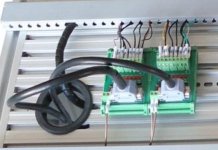I am starting to study about PLC in my free time. I have seen this kind of connector many times, but I'm not sure what it is called, and where to buy one.
I understand usually one connects inputs and outputs to the PLC by tightening the screws on the PLC... and this seems to be some kind of interface in between.
So what's the purpose of using this?
Thank you

I understand usually one connects inputs and outputs to the PLC by tightening the screws on the PLC... and this seems to be some kind of interface in between.
So what's the purpose of using this?
Thank you







